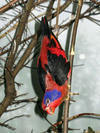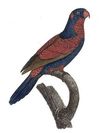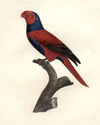Genus Eos

Red Lory - The Red Lory is the most commonly kept lory in captivity. This intelligent bird has a playful personality and a colourful appearance. Red Lories are primarily a deep red with black and electric blue markings on the wings and rump, pattern varies from individual to individual. The tail is darker maroon. They range in size from ten to twelve inches long and have an orange beak.
Black-winged Lory - An Indonesian endemic, the Black-winged Lory is distributed to forests and coastal habitat of Biak, Numfor, Manim and Mios Num islands in Cenderawasih Bay, Papua. It frequents and roosts in coconut trees.
Red-and-blue Lory - The Red-and-blue lory, Eos histrio is an arboreal parrot endemic to Indonesia. It is classed as endangered, as it is hunted for the pet trade and has lost much of its habitat due to habitat destruction. The Red-and-blue Lory is now confined to the Talaud Islands off northern Sulawesi, Indonesia. Further populations, some apparently introduced, disappeared during the 20th century from Sangihe, Siau and Tagulandang. The population is estimated at only 5,000-10,000 birds. It is thought to be in rapid decline.
Blue-streaked Lory - It is found in the Tanimbar Islands and Babar, all in Indonesia. It was also introduced to the Kai Islands, but may be extinct there again. It inhabits mangrove, coconut groves, plantations and forests. Lories have unique "brush" tipped tongues, evolved for their diet of flower nectar and fruit. A highly active, gregarious bird known to travel in flocks and to sleep in their nests year round. Very social and affectionate, lorie have been kept as pets with growing popularity, their song is usually softer than other parrots except when alarmed or bored.
Blue-eared Lory - The Blue-eared Lory is the smallest Eos at 24 cm long. It has a red body with blue cheeks, chin, and ear-coverts, purple-blue abdomen and undertail coverts, and black streaked wings. The adult has an orange beak with juvenile's pink.






